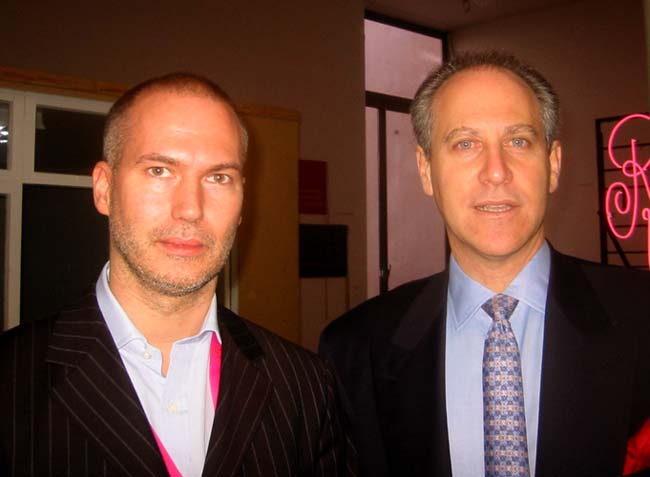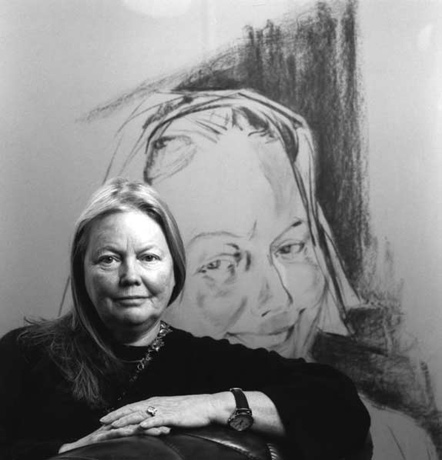blogs
Continuo blogged full ‘viral symphOny’
blogged full ‘viral symphOny’ here: http://continuo.wordpress.com/2009/01/16/joseph-nechvatal-viral-symphony...

Interviewing The Crisis - Art Is Open Source interviews Marc Garrett.
Walking a Fine Line - Russian Video Art @ Monkeytown Brooklyn

Ministry of Culture, Russian Federation
National Center for Contemporary Arts, Ekaterinburg branch in collaboration with International Fine Arts Consortium and Perpetual Art Machine (PAM)
Presents
Walking a Fine Line
Parables of the Sublime and the Subversive in Russian Video Art.
Curated by: Ksenia Fedorova and Alisa Prudnikova
January 9 (Friday), 7:30pm
Monkey Town:
58 N 3rd St. (btw. Kent & Wythe), Williamsburg, Brooklyn 11211
The program showcases the recent Russian video art works that reflect complex and controversial attitude towards the phenomenon of the sublime in Russian culture and mentality. Artists confront mystification and sacralization, engagement and spiritual detachment with strategies ranging from epatage to derision, eccentricity, and radical activism. Whom to blame? What to do? The viewer is invited to ponder upon these and other perennial “Russian” questions and find his/her own “fine line” of authentic response.
Willoughby Sharp (1936-2008)
Willoughby Sharp was a man of art, in the old fashioned sense Thomas Craven meant it. He was fully committed to every facet of a life spent waiting on the muse, wherever it would lead him, from the meanest squalor and confusion to the grandest scene of triumph.
*particle group* opens at CAL NanoSystems Institute (CN(S)I)-Jan. 14th, 2009
Particles of Interest
*particle group*
*an interactive installation of multilingual meditations
on nanotechnology, culture, and property*
Opening Reception: Wednesday, January 14, 5-7pm
Exhibit Dates: January 14 - February 4
CALIFORNIA NanoSystems Institute (CN(S)I) UCLA
As part of the *Scalable Relations* series of networked exhibitions that
Performance Power Grab, and MoMA Gets a Sehgal
January 1, 2009. On reading Erica Orden's "Collecting Smoke" text in New York Magazine examining MoMA's upcoming two year performance art initiative, which includes a Marina Abramovic retrospective and the acquisition of Tino Sehgal's The Kiss, all under the direction of the very enterprising Klaus Biesenbach, I felt compelled to jot down a couple of thoughts. A version of the text below also appears as a comment under my pseudonym on the New York Magazine site.
 Klaus Biesenbach and Glenn Lowry, 2004
Klaus Biesenbach and Glenn Lowry, 2004
Tino Sehgal was selected for the German pavilion at the 2005 Venice Biennale, was shortlisted for the Hugo Boss Prize, and has been a darling of a small but influential coterie of international jet setting curators of which Biesenbach counts himself a particularly ambitious member. So it is not surprising to see MoMA finally buy one of the "constructed situations" pieces, following the lead of the Tate and the Walker. To paraphrase another Sehgal work, "This Is Not New", especially for a curator eager to establish his bonafides over an entire realm of artmaking.
Electronic Civil Disobedience in Solidarity with Greek Anarchists
Hola all,
This e-action is being done by ECD krews in the E.U. and beyond.
Do not be afraid to download and join - they have done a really lovely
addition of ECD (super upgrade!).
My very very best to all of you in these hard times in a mad mad world!
Ricardo
>>>>>>(Forward Widely)>>>>
Electronic Civil Disobedience in Solidarity with Greek Anarchists
(Forward Widely)
Obituary of Willoughby Sharp in the New York Times, December 31, 2008
I have been watching the pages of the New York Times for an obituary of Willoughby Sharp. Joseph Nechvatal emailed me from Paris this morning with news of its publication.
The piece, by Margalit Fox, is found on page B16 of the New York print edition of December 31, 2008. It appeared online a day earlier, accompanied by a 1967 picture of Willoughby with long hair, dark glasses and wearing a white turtleneck/tunic ensemble.
I also referenced the piece on the Sharpville site.

Willoughby Sharp, 72, Versatile Avant-Gardist, Is Dead
By MARGALIT FOX
Published: December 30, 2008
Even by conceptual-art standards, Willoughby Sharp’s work stood out. There was his gestational spin in a clothes dryer. There was the curious affair of the talcum powder, the teddy bear and the tab of LSD. And there was the Oklahoma Gun Incident, which members of the art world still discuss, with a mixture of horror and awe, more than 30 years later.
Mr. Sharp, the Ivy League-educated scion of one of New York’s most socially prominent families, who in the 1960s and afterward was on the cutting edge of the American avant-garde as a performer, producer, writer, publisher, curator, video artist and much else, died on Dec. 17 in Manhattan. He was 72 and lived in Brooklyn.
Alanna Heiss Officially Retiring from P.S. 1

December 29, 2008. From Artforum.com via the New York Press comes word that the retirement of Alanna Heiss as director of the P.S. 1 Contemporary Art Center, rumored for months if not years, has finally been made official. A press release was issued today by the Museum of Modern Art, the behemoth that absorbed P.S. 1 almost a decade ago.
Heiss founded The Institute for Art and Urban Resources in 1971, with the mission of turning underutilized buildings in New York City into artist studios and exhibition spaces. In 1976 she established P.S. 1 (Project Space One) in a huge, abandoned schoolhouse in Long Island City, Queens. It was a time of experimentation, conceptualism, post-minimalism, installation, video and performance art, of scrappy alternative art spaces with modest economies and big dreams, a commercial hiatus after the glut of Pop had run its course but before the burgeoning Neo Expressionist movement added social cachet and market share to the scene. The art gods of the moment included Lawrence Weiner, Richard Nonas, Keith Sonnier, Dennis Oppenheim, Robert Smithson, Gordon Matta Clark, Vito Acconci, Joseph Kossuth, James Turrell, Richard Tuttle and Bruce Nauman.
For over thirty years, Heiss has been P.S. 1's only director and its very visible figurehead. An idiosyncratic visionary who often runs the space like a personal fiefdom, she is given to an uncompromising, by-the-seat-of-her-pants management style. This allows for bursts of curatorial and organizational brilliance, for early discoveries of emerging artists, collaborations with young curators and critics, and for challenging the paradigms of exhibition. Heiss has a mercurial temperament, an impulsive energy marked by sudden enthusiasms and antipathies. She has been described as "feisty" and "brassy". This can bring dramatic successes but also public failures, the built-in flip side of a highly experimental posture.

